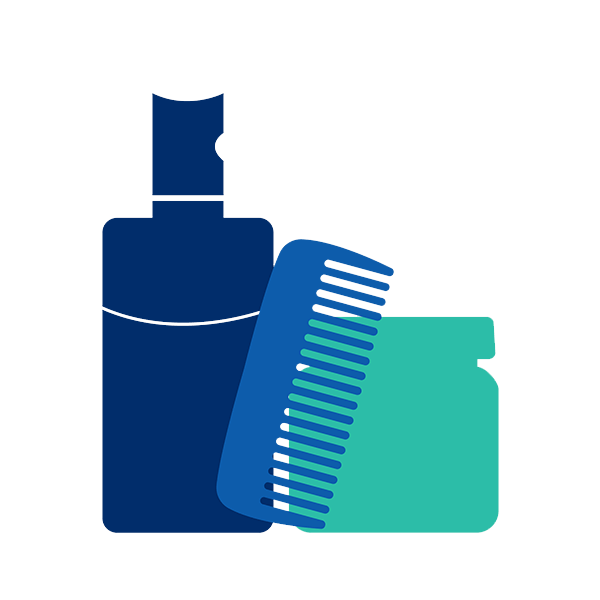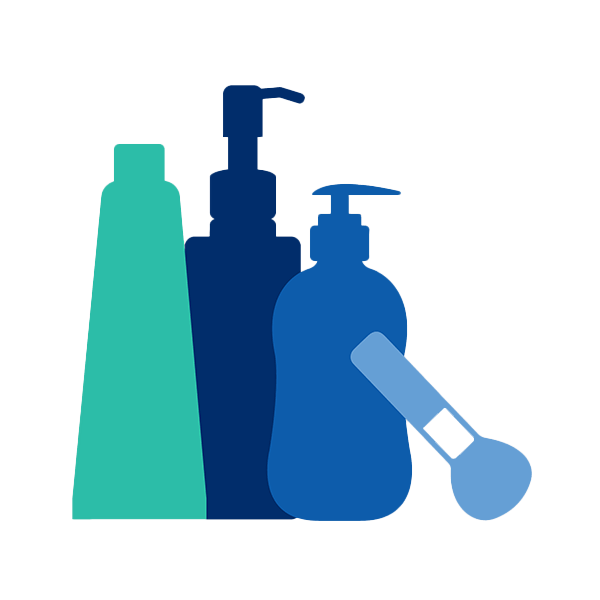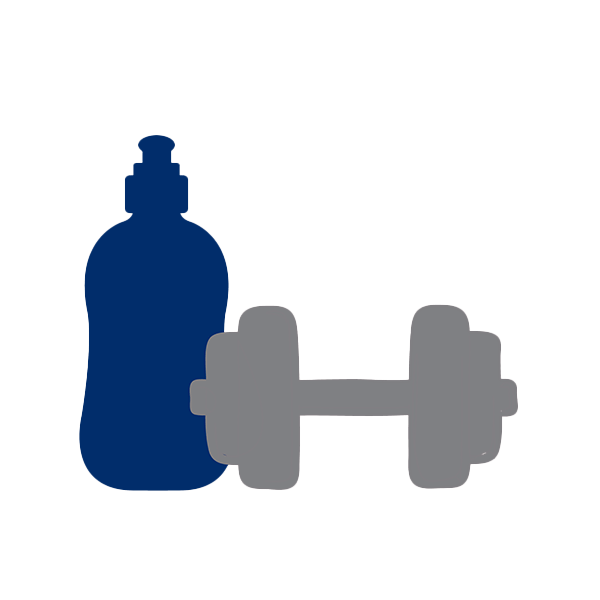
Your hair
Always comb hair gently and use a mild shampoo.
If hair starts to thin, consider cutting it short or even having it neatly clipped to the scalp by a professional hairdresser. The close-cropped or shaved head look is popular with many men and can offset concerns about patchy hair loss.
Just remember, doctors caution against shaving the scalp with a razor as it can cause hard-to-heal cuts that can result in infection when blood counts are low.
Remember to always moisturise the head regularly and use sun protection if hair loss has occurred.
There are many hat and cap styles available but it’s best to look for options made from natural fibres like cotton, linen, wool and silk – or at least make sure the lining is.
Opt for hats with a wide brim and a gusset that sits firmly around the nape of your neck to ensure maximum sun protection.
There are also hair prostheses available to conceal bald spots. As hair starts to grow back, these can be phased out.
Hair prosthesis may require some styling and can be cut to give a natural look - it’s best to speak to a professional wig specialist who will be able to provide advice around what might work best for you.
If you have private health insurance, you may be entitled to a reimbursement for the cost of your wig if it is considered a “medical prosthesis”.
Speak to your health fund to determine your eligibility, and for information on how to lodge the claim correctly.
Visit our Headwear Contacts page for a list of wig and headwear suppliers in your state.
Treatment can cause your eyebrows to thin or fall out completely. Eyebrows can be brushed, smudged, or filled in with pencil to look natural. Using short feathery strokes will give the illusion of natural fullness but do be wary that drawing in the whole brow can look a little obvious on men.
As an alternative, try wearing glasses with heavy frames, which can add definition to the area and disguise hair loss, giving the illusion of a fuller brow.
If you do want to draw on your brows, the following guide will help you map them:
- To start, hold a brow pencil or angled brush (for brow powder) straight up against the dimple of the nose, parallel to the inside corner of the eye. This is where the eyebrow should begin. Draw a small dot to mark the spot.
- To find the arch, place the pencil or brush at the outermost part of your nostril, across the centre of the iris and mark it with another small dot.
- To define the end of the brow, place the pencil or brush diagonally from the outermost part of the nostril, past the outer corner of the eye and draw the final dot.
Now there are three dots marking the basic eyebrow shape, use short, light and feathery strokes to connect them. For a natural look, make the brow a little fuller at the beginning and slightly thinner towards the end.
The look of the brow can be softened by running a spoolie brush, a cotton bud or your finger lightly through it.
Visit the Video Guides page for a step-by-step video tutorial on how to map your brows.

Your skin and body
Use a cleanser twice daily to avoid any build-up of dirt and grime which can lead to infection.
Use warm (not hot) water to open pores and protect surface capillaries.
Cleanse your skin using a gentle, creamy or foaming cleanser. Warm a small amount of product between the hands then gently massage it over your face and neck, avoiding the eye area.
Remove it using a gentle swiping motion with a soft, wet towel or wash cloth.
To remove any excess cleanser residue, a mild alcohol-free toner can also be applied to a cotton pad and gently swiped across the skin from the centre of the face outwards, avoiding the eye area.
It’s best to avoid exfoliating products while you are undergoing treatment as they may be too harsh for your skin.
During treatment your skin will be more susceptible to cuts, bruising, infections and excess bleeding. If you are not experiencing hair-loss, or if your hair-loss is patchy, it is important to consider your shaving routine.
Your doctor may suggest that you switch to an electric razor to prevent potential cuts. If you are more comfortable using a manual razor, discuss this with your doctor first and be sure to keep it sharp, always rinse it well after use, and shake off excess water without wiping. Try to use a good quality razor, not disposable and replace the blades regularly. Don’t borrow or share your razor.
Prior to shaving, always prepare the skin first with warm water or a warm towel, and rinse afterwards with cool water. Don’t rub the skin too hard before shaving as this can cause razor-burn. Be sure to gently pat your skin dry rather than rubbing it.
Hair follicles can be softened with a gentle shaving cream by leaving it on your face for about one minute before the first stroke.
To reduce stinging, let the skin rest after shaving before applying other products. It’s best to avoid applying alcohol, menthol or strong fragrance to the skin after shaving as it can cause further irritation and if possible, try to take a break from shaving now and then to let your skin rest.
Using a moisturiser morning and night will keep the skin hydrated while protecting from environmental damage caused by pollution, sun, wind and everyday living.
For the face, squeeze or scoop a small amount of moisturiser into your hands and warm it up before applying it to the cheeks, forehead, chin and neck using soft gentle patting movements, or gentle upward strokes.
A special eye cream can be applied around the delicate eye area by gently patting the ring finger around the orbital bone.
To avoid infections, be sure to scoop products out of containers with clean cotton balls, sponges, or cotton swabs rather than dipping your fingers directly into the product.
Your lips may also experience dryness during treatment. Keep things natural with a simple, hypo- allergenic lip balm with an SPF to keep you moisturised and prevent burning during the day.
For the body and hands, moisturise often and reapply throughout the day if possible — especially after washing your hands and always right before bed.
Bathing in warm - not hot - water will help prevent the skin drying out further. Apply moisturiser within three to five minutes of your bath or shower when your skin is most absorbent using gentle, hydrating products without strong fragrances.
Sunscreens either absorb or reflect UV radiation. They do this via ingredients called ‘UV filters’ and there are two main categories of UV filters:
- Organic filters absorb UV radiation – these are sometimes referred to as ‘chemical sunscreens’. These are sunscreens that most of us are used to and absorb UV rays. They must be applied on clean, dry skin before moisturiser.
- Inorganic filters scatter and reflect UV radiation – these are sometimes referred to as ‘physical' or 'mineral sunscreens’. These often use active minerals like zinc oxide and titanium dioxide to reflect UV rays and as their name suggests, provide a physical barrier. They must be applied to the skin after moisturiser.
Sunscreen should be applied during your daily morning routine to help avoid incidental sun damage. Look Good Feel Better follows the recommendations of the Cancer Council Australia in regards to sunscreen use. Look for a broad-spectrum sunscreen with a minimum protection of SPF30.
Massage the sunscreen into your face, neck and ears (avoiding your eyes) 20 minutes before you go outside, and reapply at least every two hours. Apply half a teaspoon of sunscreen to the face, neck, ears and the scalp if you have experienced hair loss, and one teaspoon to each limb, the front of the body and the back of the body.
Always patch test sunscreen, store it in a cool and dry place, and be mindful of its expiry date. Although some products like moisturisers contain SPFs, you should always use a dedicated sunscreen underneath.
It's important to remember no sunscreen, even if it is reapplied regularly, offers complete protection against UV radiation. Always use sunscreen in conjunction with other forms of sun protection like protective clothing, a hat, and sunglasses, and seek shade when outdoors. A hat that provides shade on the neck is particularly important if hair loss has been experienced as a result of treatment.
All primary sunscreens on the Australian market are subject to rigorous safety checks by the Therapeutic Goods Administration and must additionally meet mandatory quality and performance tests specified by Australian Standards. For more information on this, visit the TGA website tga.gov.au/products/medicines/sunscreens/how-tga-regulates-sunscreens
Colour correctors and concealers are useful tools to help balance obvious colour changes to skin tone. You may have noticed redness, sallowness or dark spots appearing as a side-effect of treatment. Think about the opposite colours on a colour wheel to determine what colour will correct each issue.
Green correctors will minimise redness in the skin; mauve or blue correctors lift the complexion and add warmth combating sallowness; and yellow correctors help cover pigmentation and dark circles.
Concealers contain light-reflecting particles and are also perfect for camouflaging dark circles under the eyes.
Correctors and concealers can be applied with fingers, a cotton bud or a sponge. Leave the product on the skin for a few seconds allowing it to warm and soften, then gently press it into the skin with the ring finger or a sponge to blend. You can gently blot away any excess with a tissue or cotton bud.
A moisturiser with a tint can also be used and can simply be gently massaged into the skin in the same way a normal moisturiser is used.
Be sure to use concealers and tinted moisturisers that match your skin tone – the staff in your local pharmacy or department store beauty counter will be able to assist you with finding suitable, discreet products.
Treatment can sometimes affect your fingernails and toenails and you may notice lines or indentations on your nails at different cycles/stages of your treatment - this is temporary and will eventually grow out.
The skin or cuticles around the nail may fray or peel. Discolouration or pigmentation may occur. Nails can become more brittle and prone to breaking and may lift and completely detach from the nail bed.
You can manage this by trimming your nails often. Keep them short and rounded and make sure you keep them clean. Smooth jagged edges with a nail file and remove hangnails promptly with nail clippers, to avoid catching. Use nail implements cautiously so you do not damage the skin.
Should your nails begin to lift from the bed, ensure you’re practising good hand hygiene to prevent any infections.
If your cuticles/skin around the nails begins to fray, remove it very carefully using sharp nail scissors - don’t pick at or peel the skin.
Consider using gloves when doing household jobs that may result in infection and use a hand cream often to keep your hands and feet moisturised and prevent any avoidable peeling or irritation.
Good oral hygiene is also important during treatment, and you should consult your dentist for more information on dental and oral care.
During cancer treatment you are at increased risk of infection so it is important to be mindful of hygiene with your skincare products. Here are a number of things to look out for:
- Make sure your hands are clean before applying any products.
- Tightly close all jars, tubes and containers.
- Scoop products out of containers with clean cotton balls, sponges, or cotton swabs rather than dipping your fingers directly into the product.
- Always check the expiry date on your products and replace them as required. Look for an illustration of a jar with a number inside it on the outer packaging or label of jars, tubes or compacts. This symbol indicates the number of months the product can be used after opening.
- Do not share your products or applicators with anyone.
- Always test new products on the back of your hand or wrist first, not your face, in case you have a reaction.

Your fitness
Exercise is important for mental and physical wellbeing and quality of life. Exercise should be a priority but it needs to invigorate you, not wear you out.
Every person is different. Even those of a similar age and gender and with the same cancer type can be affected differently by cancer treatments. As such there are no hard and fast rules in relation to how much or how little exercise you may be able to do.
Many of the medications prescribed for those undergoing treatment come with side effects which can impact your joints, respiratory system and general feelings of wellbeing. You may have to frequently adjust how hard and how long you exercise based on your capabilities, and any physical problems or side effects related to the type of cancer you have. It’s best to speak to your oncologist, GP or an accredited exercise physiologist or physiotherapist to help you develop an exercise program to ensure you exercise safely.
You can search for an accredited exercise physiologist at Exercise & Sports Science Australia’s website essa.org.au/find-aep, or for a physiotherapist at the Australian Physiotherapy Association’s website choose.physio/findaphysio.
As a general rule, Australia’s Physical Activity and Sedentary Behaviour Guidelines for Adults recommend that you should:
- aim to be active on most - preferably all - days of the week
- do a total of 2½ to 5 hours (150 to 300 minutes) of moderate intensity exercise throughout the week
- do 2–3 strength-training (resistance) sessions a week
- break up long periods of sitting as often as you can
For more information about the guidelines, see health.gov.au and search for “physical activity”.
Most importantly, finding an exercise program that you enjoy will help you stay motivated and feel more energetic.
And remember, if you are avoiding moving any part of your body due to pain, stiffness or fear then it is essential that you speak to your oncologist or GP who may suggest you see a physiotherapist for a physical assessment to help get you moving safely again.
We can all struggle with motivation at the best of times. Here are a few pointers on staying motivated and keeping up the healthy habits.
- Create a regular healthy behaviour so that it becomes a habit.
- Get a friend to join an activity with you so it becomes a social occasion.
- Set an activity goal for yourself every week and be as physically active as your abilities allow.
- Join in with something you will enjoy – swimming, dancing, walking, bowling, or a special exercise class for those who have had the same cancer experience as you.
- Book and pay for a block of sessions and put the dates in your diary to motivate you to attend.
- Start slowly and listen to your body - short regular sessions can be helpful, especially when you are starting out and don’t have the energy for a long exercise session. Rest when you need to.
Some days may be harder than others, but even a few minutes of light exercise is better than no exercise at all.

Your mind
Getting outside and reconnecting with nature - exercising, going fishing, or gardening, for instance - can help reduce stress, lift depression, improve energy and boost overall wellbeing.
Stress can also be greatly reduced when we increase our social connections. Catching up with friends and family can help lift the spirits.
Massage therapy is a popular choice to help with relaxation: relaxing the muscles can often relax the mind.
Other techniques such as yoga, deep breathing and meditation may also be useful. Discuss the options available to you with your treating health professionals.
Sleep also matters. Aim for a regular routine of around eight hours sleep a night and avoid using tech devices right before bed.
It helps to have family and friends that you can turn to for emotional support. Some men also seek out others dealing with a cancer diagnosis through local or online support groups, to talk and share experiences without feeling like they’re burdening those closest to them.
Your health professionals, particularly social workers, can connect you with others in a similar situation. Cancer Australia is an Australian government resource to benefit all Australians affected by cancer and may also help you find information and support services.
Remember that knowledge is power. Take notes and bring questions to appointments. Seek out reliable information to help you make informed decisions about your treatment and care.
While you’re undergoing treatment, it can be helpful to set small goals and celebrate your wins.
Taking the first step to write down a goal gives you something to strive towards, as well as look forward to.
The sense of accomplishment that comes from achieving your goals can feel very empowering, satisfying and healing.
Don’t forget to celebrate each little win on your road to recovery.
